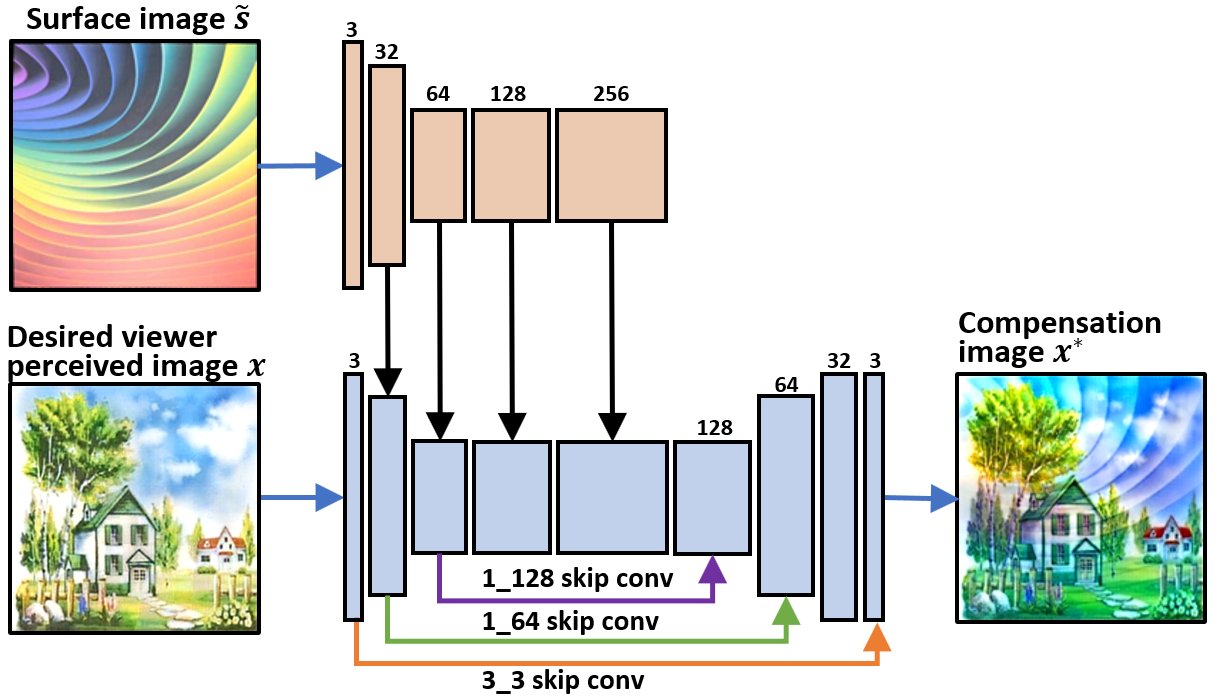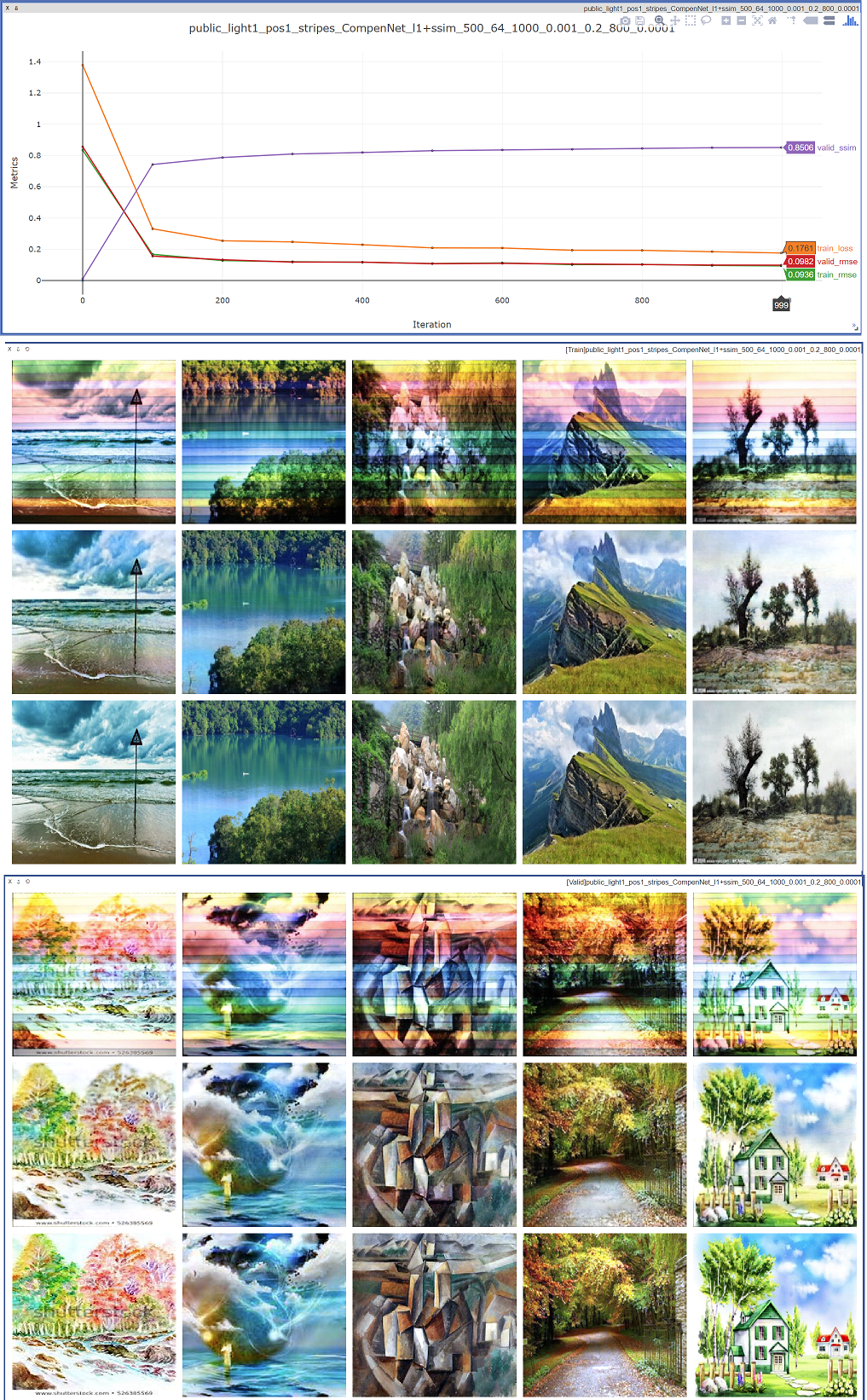PyTorch implementation of CompenNet. Also see CompenNet++ and journal version.
Highlights:
- For the first time, we formulate the compensation problem as an end-to-end learning problem and propose a convolutional neural network, named CompenNet, to implicitly learn the complex compensation function.
- A novel evaluation benchmark, which is independent of system setup and thus quantitatively verifiable. Such benchmark is not previously available.
- Our method is evaluated carefully on the benchmark, and the results show that our end-to-end learning solution outperforms state-of-the-arts both qualitatively and quantitatively by a significant margin.
For more info please refer to our CVPR'19 paper and supplementary material.
- PyTorch compatible GPU
- Python 3
- PyTorch >= 0.4.0 (note that the results in the paper were produced using this version)
- opencv-python 3.4.4
- visdom (for visualization)
-
Clone this repo:
git clone https://github.com/BingyaoHuang/CompenNet cd CompenNet -
Install required packages by typing
pip install -r requirements.txt -
Download CompenNet benchmark dataset and extract to
CompenNet/data -
Start visdom by typing
visdom -
Once visdom is successfully started, visit
http://localhost:8097 -
Open
main.pyand set which GPUs to use. An example is shown below, we use GPU 0, 2 and 3 to train the model.os.environ['CUDA_VISIBLE_DEVICES'] = '0, 2, 3' device_ids = [0, 1, 2] -
Run
main.pyto start training and testingcd src/python python main.py -
The training and validation results are updated in the browser during training. An example is shown below, where the 1st figure shows the training and validation loss, rmse and ssim curves. The 2nd and 3rd montage figures are the training and validation pictures, respectively. In each montage figure, the 1st rows are the camera captured uncompensated images, the 2nd rows are CompenNet predicted projector input images and the 3rd rows are ground truth of projector input image.
- For a planar textured projection surface, adjust the camera-projector such that the brightest projected input image (plain white) slightly overexposes the camera captured image. Similarly, the darkest projected input image (plain black) slightly underexposes the camera captured image. This allows the projector dynamic range to cover the full camera dynamic range.
- Project and capture the images in
CompenNet/data/trainandCompenNet/data/test. Note that in our setup, we stretched the image to cover the entire projection area (keep aspect ratio). - Project and capture a surface image
CompenNet/data/ref/img_gray. - Project and capture a checkerboard image.
- Estimate the homography
Hbetween camera and projector image, then warp the camera captured imagestrain,testandimg_grayto projector's view usingH. - Finally save the warped images to
CompenNet/data/light[n]/pos[m]/warp/[surface]/train,CompenNet/data/light[n]/pos[m]/[surface]/warp/testandCompenNet/data/light[n]/pos[m]/[surface]/warp/ref, respectively, where[n]and[m]are lighting setup index and position setup index,[surface]is projection surface's name.
Note ref/img_0001.png to ref/img_0125.png are plain color training images used by TPS-based method, you don't need to use these images to train CompenNet.
- Create a new class e.g.,
NewModelinCompenNetModel.py. - Add the new class name string to
model_list, e.g.,model_list = ['NewModel', 'CompenNet']inmain.py. - Run
main.py. - The quantitative comparison results between
NewModelandCompenNetwill be saved tolog/%Y-%m-%d_%H_%M_%S.txtand an example is shown below, where prefixuncmp_means the similarity between uncompensated camera-captured images and ground truth of projector input images. Prefixvalid_means the similarity between CompenNet predicted projector input images and ground truth of projector input images. Refer to our CVPR'19 paper Fig. 3 for more details.
data_name model_name loss_function num_train batch_size max_iters uncmp_psnr uncmp_rmse uncmp_ssim valid_psnr valid_rmse valid_ssim
light2/pos1/curves NewModel l1+ssim 500 64 1000 14.3722 0.3311 0.5693 23.2068 0.1197 0.7974
light2/pos1/curves CompenNet l1+ssim 500 64 1000 14.3722 0.3311 0.5693 23.1205 0.1209 0.7943
light2/pos1/squares NewModel l1+ssim 500 64 1000 10.7664 0.5015 0.5137 20.1589 0.1701 0.7032
light2/pos1/squares CompenNet l1+ssim 500 64 1000 10.7664 0.5015 0.5137 20.1673 0.1699 0.7045
light1/pos1/stripes NewModel l1+ssim 500 64 1000 15.1421 0.3030 0.6264 24.9872 0.0975 0.8519
light1/pos1/stripes CompenNet l1+ssim 500 64 1000 15.1421 0.3030 0.6264 24.9245 0.0983 0.8508
light2/pos2/lavender NewModel l1+ssim 500 64 1000 13.1573 0.3808 0.5665 22.2718 0.1333 0.7723
light2/pos2/lavender CompenNet l1+ssim 500 64 1000 13.1573 0.3808 0.5665 22.1861 0.1347 0.7693
@inproceedings{huang2019compennet,
author = {Huang, Bingyao and Ling, Haibin},
title = {End-To-End Projector Photometric Compensation},
booktitle = {The IEEE Conference on Computer Vision and Pattern Recognition (CVPR)},
month = {June},
year = {2019}
}
The PyTorch implementation of SSIM loss is modified from Po-Hsun-Su/pytorch-ssim. We thank the anonymous reviewers for valuable and inspiring comments and suggestions. We thank the authors of the colorful textured sampling images.
This software is freely available for non-profit non-commercial use, and may be redistributed under the conditions in license.




